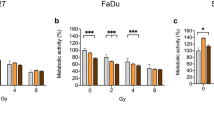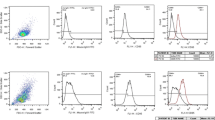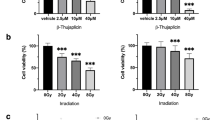Abstract
Since the prognosis of head and neck squamous cell carcinoma (HNSCC) still remains poor, identifying novel chemotherapeutic agents is of outmost importance. The anticancer potential of quinoxalines has been described in various tumor entities. Caroverine, also a quinoxaline derivative, has been shown to suppress tumor promotion factors. The aim of this study was to evaluate the effect of caroverine on HNSCC cell lines. The HNSCC cell lines SCC9, SCC25, CAL27, and FaDu were incubated with caroverine alone or in combination with cisplatin, 5-fluorouracil (5-FU) or cetuximab. Cell viability was measured using the CCK-8 assay. The murine 3T3 fibroblast cell line was used to address tissue specificity. Apoptosis was visualized by immunohistochemistry. Caroverine showed a dose-dependent growth inhibition in all cell lines, IC50 values ranged from 75.69 to 179.80 µM. This effect was increased when caroverine was combined with cetuximab or 5-FU. Immunohistochemistry displayed more apoptosis after caroverine treatment compared to controls. Furthermore, caroverine alone had no growth inhibitory effect on 3T3 cells. For the first time, this study provides evidence that caroverine may serve as a supportive drug in the treatment of HNSCC patients.





Similar content being viewed by others
References
Jemal A, Bray F, Center MM, Ferlay J, Ward E, Forman D (2011) Global cancer statistics. CA Cancer J Clin 61:69–90
Leemans CR, Braakhuis BJM, Brakenhoff RH (2011) The molecular biology of head and neck cancer. Nat Rev Cancer 11:9–22
Moarbess G, Deleuze-Masquefa C, Bonnard V et al (2008) In vitro and in vivo anti-tumoral activities of imidazo[1,2-a]quinoxaline, imidazo[1,5-a]quinoxaline, and pyrazolo[1,5-a]quinoxaline derivatives. Bioorg Med Chem 16:6601–6610
Ingle R, Marathe R, Magar D, Patel HM, Surana SJ (2013) Sulphonamido-quinoxalines: search for anticancer agent. Eur J Med Chem 65:168–186
Udilova N, Kozlov AV, Bieberschulte W, Frei K, Ehrenberger K, Nohl H (2003) The antioxidant activity of caroverine. Biochem Pharmacol 65:59–65
Nohl H, Bieberschulte W, Dietrich B, Udilova N, Kozlov AV (2003) Caroverine, a multifunctional drug with antioxidant functions. BioFactors 19:79–85
König P, Conca A, Lugmayer B (1999) Does a glutamate receptor blocker (Caroverine) enhance haloperidol in the treatment of schizophrenia? Neuropsychobiology 40:140–141
Saletu B, Grünberger J, Anderer P, Linzmayer L, König P (1995) Acute central effects of the calcium channel blocker and antiglutamatergic drug caroverine. Double-blind, placebo-controlled, EEG mapping and psychometric studies after intravenous and oral administration. Arzneimittelforschung 45:217–229
Nohl H, Rohr-Udilova N, Gille L, Bieberschulte W, Jurek D, Marian B, Schulte-Hermann R (2005) Ubiquinol and the papaverine derivative caroverine prevent the expression of tumour- promoting factors in adenoma and carcinoma colon cancer cells induced by dietary fat. BioFactors 25:87–95
Tsuruo T, Iida H, Tsukagoshi S, Sakurai Y (1982) Increased accumulation of vincristine and adriamycin in drug-resistant P388 tumor cells following incubation with calcium antagonists and calmodulin inhibitors. Cancer Res 42:4730–4733
Heiduschka G, Lill C, Schneider S et al (2014) The effect of cilengitide in combination with irradiation and chemotherapy in head and neck squamous cell carcinoma cell lines. Strahlenther Onkol 190:472–479
Heiduschka G, Erovic BM, Vormittag L et al (2009) 7beta-hydroxycholesterol induces apoptosis and regulates cyclooxygenase 2 in head and neck squamous cell carcinoma. Arch Otolaryngol Head Neck Surg 135:261–267
Denk DM, Heinzl H, Franz P, Ehrenberger K (1997) Caroverine in tinnitus treatment. A placebo-controlled blind study. Acta Otolaryngol 117:825–830
Domeisen H, Hotz MA, Häusler R (1998) Caroverine in tinnitus treatment. Acta Otolaryngol 118:606–608
Geretsegger C, Fartacek R (1998) Infusional high-dose application of the calcium-channel-blocking and antiglutamatergic agent caroverine in the treatment of alcohol withdrawal (DSM-III-R 291.80). Eur Neuropsychopharmacol 8:191–194
Rodrigues FAR, Bomfim IDS, Cavalcanti BC et al (2014) Design, synthesis and biological evaluation of (E)-2-(2-arylhydrazinyl)quinoxalines, a promising and potent new class of anticancer agents. Bioorg Med Chem Lett 24:934–939
Lee SH, Kim N, Kim SJ, Song J, Gong YD, Kim SY (2013) Anti-cancer effect of a quinoxaline derivative GK13 as a transglutaminase 2 inhibitor. J Cancer Res Clin Oncol 139:1279–1294
Ghattass K, El-Sitt S, Zibara K, Rayes S, Haddadin MJ, El-Sabban M, Gali-Muhtasib H (2014) The quinoxaline di-N-oxide DCQ blocks breast cancer metastasis in vitro and in vivo by targeting the hypoxia inducible factor-1 pathway. Mol Cancer 13:12
Chaturvedi NK, Rajule RN, Shukla A et al (2013) Novel treatment for mantle cell lymphoma including therapy-resistant tumor by NF-κB and mTOR dual-targeting approach. Mol Cancer Ther 12:2006–2017
Palanichamy K, Sreejayan N, Ontko AC (2012) Overcoming cisplatin resistance using gold(III) mimics: anticancer activity of novel gold(III) polypyridyl complexes. J Inorg Biochem 106:32–42
Conflict of interest
No conflict of interest and financial disclosures.
Author information
Authors and Affiliations
Corresponding author
Rights and permissions
About this article
Cite this article
Haymerle, G., Thurnher, D., Kadletz, L. et al. Assessment of caroverine as a potential chemotherapeutical agent in HNSCC cell lines. Eur Arch Otorhinolaryngol 272, 3451–3456 (2015). https://doi.org/10.1007/s00405-014-3364-0
Received:
Accepted:
Published:
Issue Date:
DOI: https://doi.org/10.1007/s00405-014-3364-0




